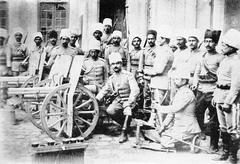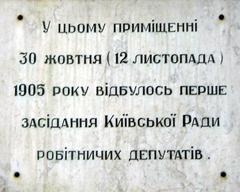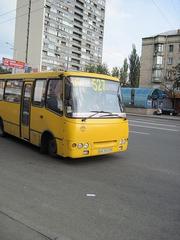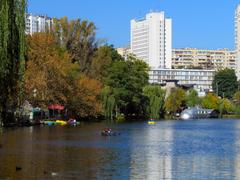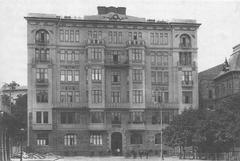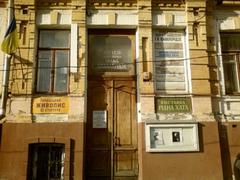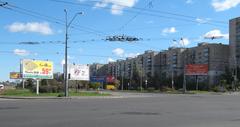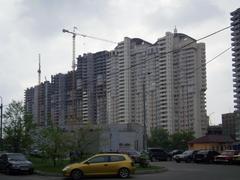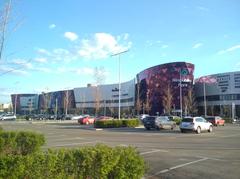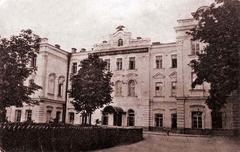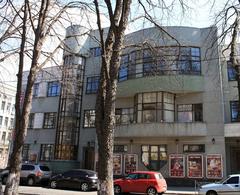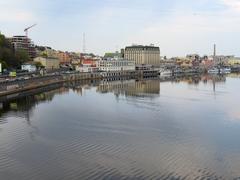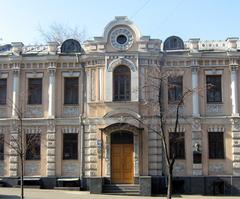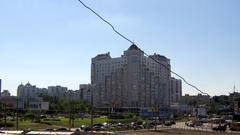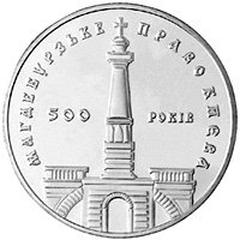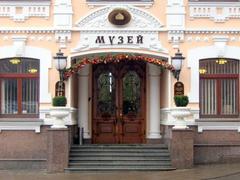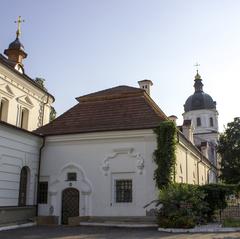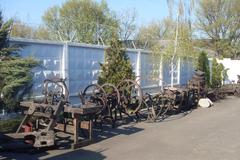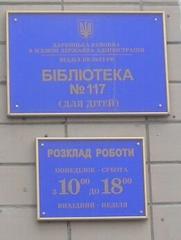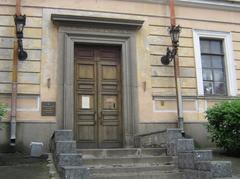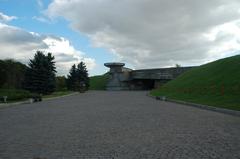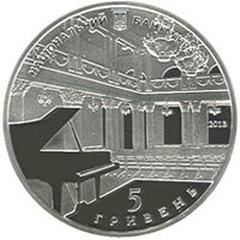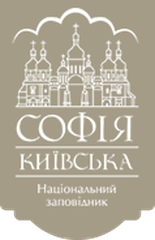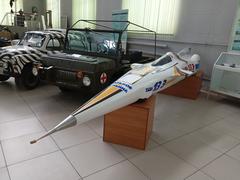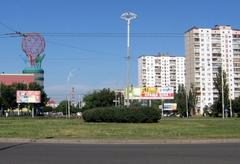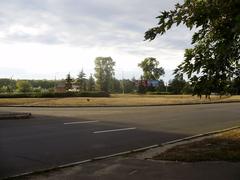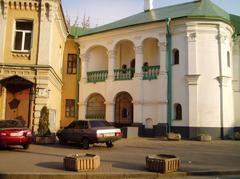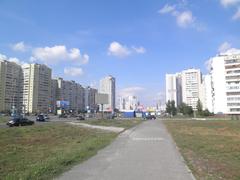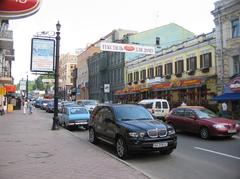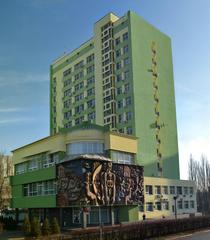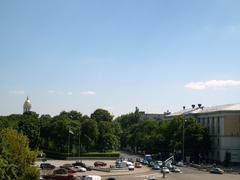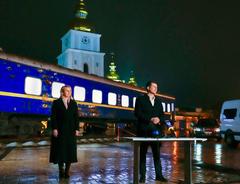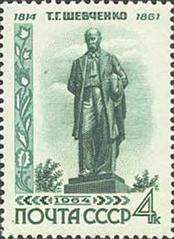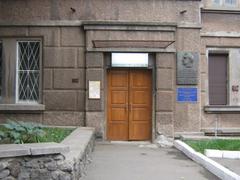Shchekavytska Square, Kyiv: Visiting Hours, Tickets, and Tourist Guide
Date: 03/07/2025
Introduction: Shchekavytska Square’s Historical and Cultural Significance
Shchekavytska Square is a vibrant emblem of Kyiv’s historical and cultural evolution, located in the heart of the Podil district. Its roots stretch back to the early medieval period, with the square occupying a prime location at the foot of Shchekavytsia Hill—an area tied closely to the city’s legendary founders and Kyivan Rus’ foundational myths (Wikipedia: Podil; World City History). Over centuries, the square has served as a commercial, artisan, and social hub, witnessing the city’s transformation through periods of turmoil and renewal.
Today, Shchekavytska Square is not just a historical landmark but a living urban space. Its architectural palette ranges from medieval remnants to 19th-century classicism and Soviet modernism, reflecting the district’s diverse history (RBC-Ukraine; Encyclopedia of Ukraine: Podil). The square’s pedestrian-friendly design, accessibility, and proximity to Kontraktova Square, Andriyivskyy Descent, and the Dnipro River embankment make it a must-see for any visitor.
Whether hosting festivals, markets, or everyday neighborhood gatherings, Shchekavytska Square epitomizes the resilience and vibrancy at the core of Kyiv’s identity (EDUCBA; Springer Link). This guide provides a comprehensive overview for travelers and history enthusiasts, offering key insights into the square’s significance, visitor logistics, and practical travel tips.
Table of Contents
- Early Origins and Medieval Development
- Mongol Invasion and Podil’s Ascendancy
- Early Modern Period: Growth and Transformation
- The Great Fire of 1811 and Urban Renewal
- 19th–20th Centuries: Commercial and Cultural Flourishing
- Soviet Era and Postwar Changes
- Contemporary Significance and Preservation
- Shchekavytska Square’s Urban Landscape
- Architectural Features and Urban Design
- Social Cohesion and Community Life
- Cultural Events and Artistic Expression
- Symbolism and Civic Resilience
- Diversity, Inclusion, and Everyday Life
- Gastronomy, Folklore, and Local Traditions
- Visitor Information: Hours, Tickets, Accessibility, and Travel Tips
- Getting There
- Nearby Attractions and Itinerary Suggestions
- Safety, Accessibility, and Practical Tips
- Photography and Local Etiquette
- Frequently Asked Questions (FAQ)
- Conclusion and Invitation to Visit
- Sources and Further Reading
Historical Overview
Early Origins and Medieval Development
Located in Podil, Kyiv’s oldest continually inhabited district, Shchekavytska Square’s history dates back to the end of the 9th century (Wikipedia: Podil). “Podil” means “lower part,” referencing its position along the Dnipro River floodplain below the city’s hills. The square, named after Shchekavytsia Hill, was integral to the artisan and trade quarters that flourished in the Kyivan Rus era. By the 12th–13th centuries, the area was a bustling center of commerce, with streets and neighborhoods often named for local crafts (Encyclopedia of Ukraine: Podil).
Mongol Invasion and Podil’s Ascendancy
The Mongol conquest of 1240 devastated Kyiv’s upper town, shifting the city’s core to Podil. Shchekavytska Square, near the Dnipro harbor, became even more vital for trade and civic life. Its network of winding streets and protective wooden fortifications supported this new urban nucleus (Encyclopedia of Ukraine: Podil).
Early Modern Period: Growth and Transformation
From the 16th century, Podil—anchored by Shchekavytska Square—grew as a center of education, commerce, and religion, symbolized by institutions like the Kyivan Mohyla Academy. The Kyiv Contract Fair, held from 1798 at nearby Kontraktova Square, cemented the area’s commercial prominence (Wikipedia: Podil).
The Great Fire of 1811 and Urban Renewal
The fire of 1811 destroyed much of Podil’s wooden architecture, prompting a redesign with a grid of wider streets. Shchekavytska Square was rebuilt with stone and brick, improving both safety and aesthetics (KievKyivUkraine.com: Podil District).
19th–20th Centuries: Commercial and Cultural Flourishing
Podil remained Kyiv’s commercial heart, with Shchekavytska Square at its center. The arrival of the tramway in 1896 enhanced accessibility. The area’s architecture reflected its multicultural character, home to Ukrainian, Jewish, and other communities (Wikipedia: Podil).
Soviet Era and Postwar Changes
Under Soviet rule, Podil’s functions shifted, with some historic buildings repurposed or replaced. However, postwar restoration efforts aimed to preserve the area’s unique character (Wikipedia: Podil).
Contemporary Significance and Preservation
Today, Shchekavytska Square is recognized for its historical and architectural value, though preservation challenges persist, especially amid the ongoing Russo-Ukrainian War (Leshchenko, 2023). Restoration focuses on maintaining authentic facades and adapting historic layouts for modern uses.
The Square in Kyiv’s Urban Fabric
Shchekavytska Square remains a vital crossroads in Podil, linking ancient trade routes with contemporary urban life. Its proximity to major attractions—including Kontraktova Square, Andriyivskyy Descent, and the Dnipro River—makes it a strategic waypoint for exploring Kyiv (KievKyivUkraine.com: Podil District).
Urban Design and Architecture
Urban Layout
After the 1811 fire, British architect William Heste’s rational grid plan redefined Podil’s streetscape. Shchekavytska Square’s current organization blends this orderly planning with the organic charm of older streets (RBC-Ukraine).
Architectural Character
- Historicist & Eclectic Styles: Late 19th–early 20th-century buildings feature neoclassical, eclectic, and art nouveau elements: ornate facades, arched windows, pastel colors, and wrought-iron balconies.
- Soviet-Era Structures: Functionalist mid-20th-century “Khrushchyovkas” reflect Soviet housing priorities.
- Contemporary Adaptations: Recent adaptive reuse has turned historic buildings into cafes, galleries, and boutique hotels, supporting both conservation and innovation (MIT DSpace).
Public Space Design
The square offers a blend of historic cobblestones and modern paving, with benches, mature trees, and tasteful lighting. Its flexible design accommodates both daily use and special events (ArchDaily).
Heritage Conservation
Podil’s protected status brings ongoing efforts to balance new development with preservation, ensuring Shchekavytska Square retains its distinct identity (RBC-Ukraine).
Community and Culture
Social Cohesion
Shchekavytska Square is a central gathering place, fostering everyday interactions among residents, students, artisans, and visitors. Its accessible design encourages inclusivity and social bonds (Springer Link; Social Life Project).
Cultural Events
The square regularly hosts open-air concerts, art fairs, and seasonal festivals, celebrating both traditional and contemporary Ukrainian culture (EDUCBA). During national holidays, it becomes a focal point for communal gatherings and performances.
Symbolism and Resilience
While larger squares like Maidan Nezalezhnosti are better known internationally, Shchekavytska Square plays a vital role in local civic life, supporting grassroots initiatives and public discourse (World Cities Culture Forum).
Diversity and Inclusion
The square is designed for access by people of all ages and abilities. Adjacent markets and workshops foster economic and social integration across different backgrounds (Springer Link).
Gastronomy and Folklore
Street food vendors, cafes, and farmers’ markets offer local delicacies, while regular performances and storytelling events keep folk traditions alive (EDUCBA).
Visitor Essentials
Visiting Hours and Tickets
- Square Access: 24/7, free of charge.
- Nearby Attractions: Museums, such as the Great Choral Synagogue and Chernobyl Museum, generally open 10:00 AM–6:00 PM; check specific sites for ticketing (mapcarta.com; tourspilot.com).
Accessibility
- Pedestrian-friendly with paved pathways and ramps.
- Some cobblestone areas may be uneven.
- Metro stations (Kontraktova Ploshcha and Poshtova Ploshcha) and tram/bus lines provide easy access.
- Taxis and ride-sharing apps are widely used (mapcarta.com).
Travel Tips
- Best Times: Spring, summer, and autumn for lively events and markets; early mornings or weekdays for fewer crowds.
- Safety: Kyiv remains generally safe, but follow current advisories, be mindful of the midnight–5:00 AM curfew, and download the “Air Alert Ukraine” app for updates (xplrverse.com; visitukraine.today).
- Language: Ukrainian is official; English is spoken in tourist areas.
- Payments: Cards are widely accepted, but cash may be needed for markets.
- Wi-Fi: Common in cafes; consider a local SIM for data.
- Facilities: Limited public restrooms—use those in cafes or museums.
Getting There
- Metro: Kontraktova Ploshcha (Blue Line, M2), about 10 minutes on foot.
- Tram/Bus: Multiple lines serve Podil.
- Taxi/Ride-Share: Uklon, Bolt, and similar apps are reliable.
- Biking: Bicycle infrastructure is improving (Bucketlistly Blog).
Nearby Attractions
- Great Choral Synagogue: Open 10:00 AM–6:00 PM (mapcarta.com).
- Chernobyl Museum: Open daily 10:00 AM–6:00 PM; guided tours available (tourspilot.com).
- Andriyivskyy Descent: Historic street with galleries and cafes (thetouristchecklist.com).
- Podil Markets: Fresh produce, crafts, and souvenirs (bigworldsmallpockets.com).
Dining and Refreshments
- Local Cafés: Try Holy Beans for specialty coffee (bigworldsmallpockets.com).
- Traditional Cuisine: Family-run restaurants serve borscht, varenyky, and more.
- Street Food: Chebureki, pastries, and quick bites, especially on weekends.
Events and Activities
- Occasional local festivals, open-air concerts, and artisan fairs—especially in warmer months (tourspilot.com).
Photography and Etiquette
- Best light: Early morning and late afternoon.
- Ask permission before photographing people, especially at religious or market events.
- Dress modestly for religious sites; tipping (10–15%) customary in cafes.
Itinerary Suggestion
- Morning: Coffee at a local café, visit the Great Choral Synagogue.
- Midday: Tour the Chernobyl Museum.
- Afternoon: Explore Podil Markets and Andriyivskyy Descent.
- Evening: Dine at a traditional restaurant or enjoy live music.
Frequently Asked Questions (FAQ)
Q: What are Shchekavytska Square’s visiting hours?
A: Open 24/7; museums and markets generally operate 10:00 AM–6:00 PM.
Q: Is there an entrance fee?
A: No, the square is free; nearby attractions may charge admission.
Q: Is the square accessible for people with disabilities?
A: Yes, though some areas have cobblestones.
Q: What’s the best way to get there?
A: Metro (Kontraktova Ploshcha), tram, bus, or taxi.
Q: Are guided tours available?
A: Yes, for both the square and nearby museums.
Q: Is it safe to visit in 2025?
A: Generally yes, but monitor current advisories and follow local protocols.
Summary and Invitation
Shchekavytska Square masterfully blends history, culture, and community life in Kyiv’s Podil district. From medieval trade center to vibrant modern gathering place, it offers a rich narrative of resilience and transformation (Encyclopedia of Ukraine: Podil; KievKyivUkraine.com: Podil District). Its architecture, events, and markets create a visually and socially engaging experience for all.
Despite ongoing challenges, preservation efforts ensure that Shchekavytska Square remains a vital part of Kyiv’s heritage (Leshchenko, 2023). Visitors are encouraged to explore respectfully, enjoy guided tours, and immerse themselves in Podil’s unique atmosphere.
Plan your visit to Shchekavytska Square and experience the pulse of historic and contemporary Kyiv! For up-to-date information and immersive experiences, download the Audiala app and follow local event updates.
Shchekavytska Square in Kyiv, surrounded by historic buildings and bustling streets.
Sources and Further Reading
- Podil – Wikipedia
- Podil – Encyclopedia of Ukraine
- Podil District Walking Tour – KievKyivUkraine.com
- The Fascinating History of Kyiv, Ukraine – World City History
- Tourist Attractions in Kyiv – EDUCBA
- How Old Is Kyiv Really? – RBC-Ukraine
- Methods and Techniques for Preservation – Leshchenko (2023)
- Squares: Hearts of Communities – Social Life Project
- Kyiv’s Cultural Resistance – World Cities Culture Forum
- Urban Design, Street and Square – Academia.edu
- Kyiv Tourism Official Website
- Mapcarta: Shchekavytska Square
- Tourspilot: Things to Do in Kyiv
- The Tourist Checklist: Things to Do in Kyiv
- Big World Small Pockets: Things to Do in Kiev
- Xplrverse: Is Ukraine Safe in 2025?
- Visit Ukraine: 2025 Rules and Safe Cities
- Bucketlistly Blog: Kyiv Guide
- ArchDaily: Public Space Designs
- MIT DSpace: Urban Development in Kyiv
